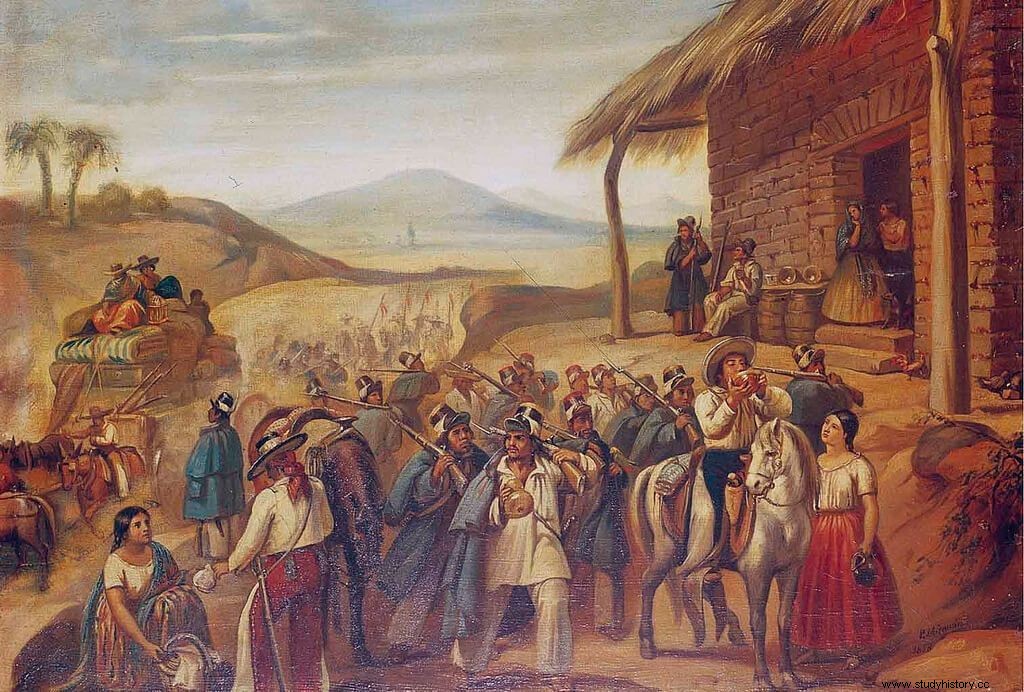
We could place the germ of the War of Reform in the American intervention of 1846. The young American army managed to defeat the Mexican in a series of decisive battles. The defeat in the war produced great discomfort in Mexico, since it meant the loss of important territories in the north, approximately half of the national territory, and began to tense the political environment in the country.
Until then there had been a Federal Republic and a Centralist Republic. Each of them had had its presidents, such as the famous Antonio López de Santa Anna that, between 1853 and 1854, acted with dictatorial powers. On March 1, 1854, General Florencio Villarreal, seeing the degeneration of Santa Anna's government, began the Ayutla revolution, which sought the expulsion of the dictator.
The beginning of the revolution provoked a civil war in Mexico. Those who supported Florencio Villarreal wanted an interim president to be installed again in the country and for a congress to create a new constitution. The combats between opponents and government resulted in the victory of the former. Before his total defeat, Antonio López Santa Anna called a plebiscite to try to legitimize himself once again in the face of society. The results were totally negative and the Mexican general had to abandon politics. His fall was replaced by a presidency led by Juan Álvarez, who had placed himself in command of the Liberals during the Ayutla revolution.
After a constituent congress, Juan Álvarez gave way to Ignacio Comonfort who governed between December 1855 and January 1858. The presidencies of Juan Álvarez and Ignacio Comonfort were characterized by the creation of the Reform Laws which would ultimately be the cause of the conflict due to the impact they had on traditional Mexican society. In general, they intended to end the privileges of the Catholic Church in the country (Ley Juárez ), adding a process of confiscation of the properties of this and the communal lands (Lerdo Law ). With this declaration of intent, the Church did not stand still and financed uprisings against the new government, something confessed by Pelagio Antonio de Labastida himself, bishop of La Puebla[1].
The Constitution of 1857
February 5, 1857 saw the birth of the new constitution. This had a radical liberal cut and from the first moment it caused problems. Apart from the processes against the Church and its privileges, the 1857 Constitution added freedom of worship and education, as well as establishing Mexico as a federative Republic in 23 states in the style of the United States. Throughout this year elections were called again and on December 1 Ignacio Comonfort he was re-elected president together with Benito Juárez , who would be a minister of the Supreme Court of Justice. Comonfort did not last long in his position. He himself declared that the constitution was too radical and that it would be very difficult to govern the country with its application.
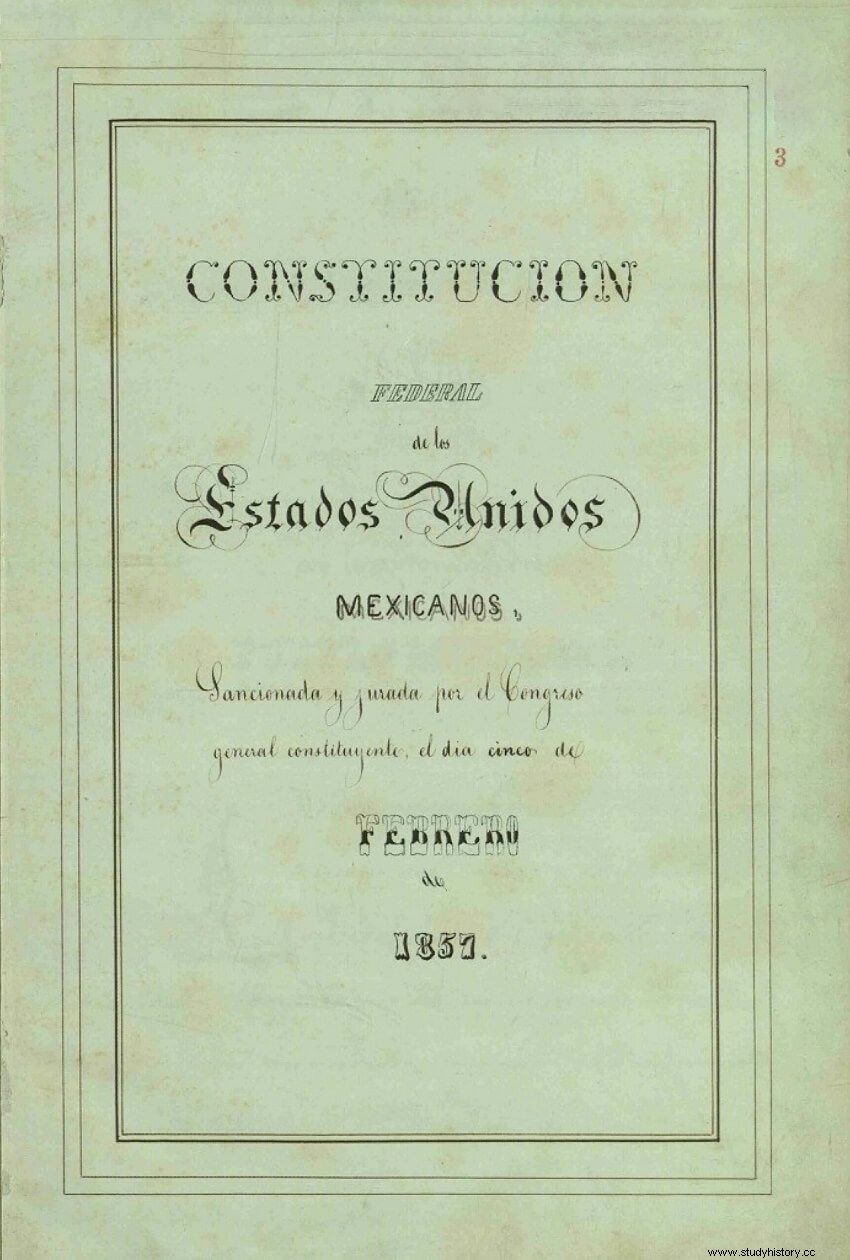
Ignacio Comonfort started movements against his own party , first contacted the leaders of the conservative party to form and initiate a new congress that would draft a new Magna Carta, all within what became known as the Tacubaya Plan . The liberal president invited Benito Juárez to be part of this commission, but he refused and was imprisoned. Seeing the situation of discord between the Liberals, the Conservative leaders provisionally elected General Félix Zuloaga as president. Comonfort tried to back down from his intentions, but his party withdrew their support. Despite everything, the now deposed president managed to free Juárez, who retired to Guanajuato[2] and created a government on January 18, 1858.
Beginning and development of the Reform War 1858-1861
With the creation of two totally different political entities and with very different objectives, Mexico headed towards civil war between the liberals led by Benito Juárez and the conservatives led by General Félix Zuloaga. The conservatives obtained the social and, above all, financial support from the Mexican Catholic Church, although the army and the clergy did not have a good relationship. Its capital was installed in Mexico City. Meanwhile, the liberal government of Juárez had its seat of government in Veracruz.
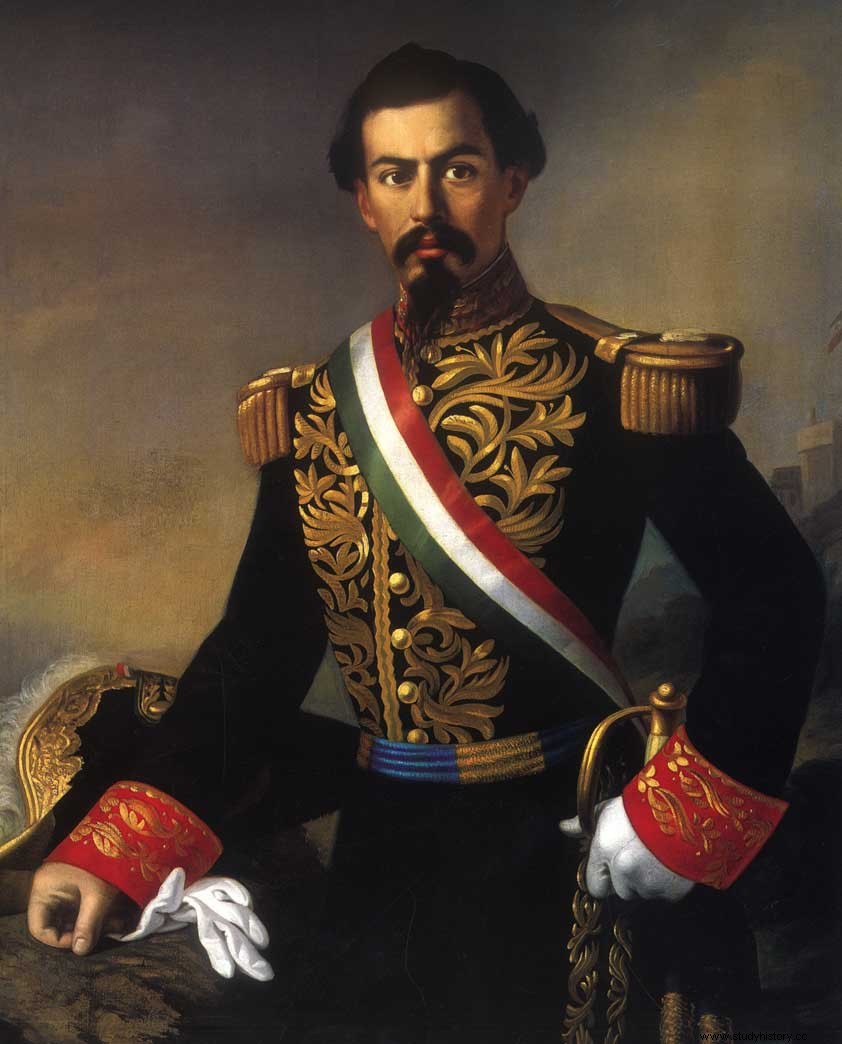
The conservatives had the support of part of the National Army . However, although they took control of Mexico City, they quickly failed to defeat the Liberals definitively in the first campaigns of the War of Reform. The victories were of more propaganda than strategic importance, and the Liberals were thus able to recover from these initial disasters. The conservative army began a series of purges within it. In them, the chiefs who were constitutionalists were eliminated and dismissed and, on the contrary, the officers who were of conservative sentiments were reincorporated into the ranks. At its peak, the conservative army managed to have in ranks about 22,000 men divided into 15,500 infantry and just over 6,400 cavalry[3]. This army consumed great resources of the small conservative state, which limited the campaigns.
The constitutional army it was forged based on the so-called National Guard before the Reform War. A good number of garrisons joined the Liberal cause, although defeats at the hands of the Conservatives caused some of these units to change sides. In any case, the National Guard served as a model and example for the new liberal army that was being created at the time. After the first hardest moments, the incipient liberal army managed to carry out useful recruitment campaigns among the populations and reach a balance of forces against the enemy. Liberal army leaders were also learning as the conflict dragged on. Among them stood out Santiago Vidaurri and Santos Degollado.
The Mexican historian Eduardo Paz divides the fronts of the War of Reform into three:the North (Chihuahua, Coahuila, Durango, Guanajuato, Nuevo León, San Luis Potosí, Sinaloa, Sonora , Tamaulipas and Zacatecas), the Center (Colima, Jalisco, Mexico, Michoacán, Puebla, Tlaxcala and Veracruz) and the South (with the remaining states)[4]. Regarding the stages , the historian José Bravo Ugarte also speaks of three well-defined.
The first one began with the beginning of hostilities in February and ended two months later in April of the same year 1858. The Conservative army under the command of General Luis G. Osollo he achieves two triumphs on the battlefields, which are generally far from population centers. The presidency of Benito Juárez is in danger and from Guanajuato he moves to Veracruz. Even after a series of defeats he must leave the country for fear of being captured. After this first conservative impulse, a balanced situation is reached. It passes to the second stage of the war that extends from May 1858 to June 1860. The longest stage of the conflict.
The liberal government achieves a balance of forces against the conservatives. Battles usually take place far from urban centers, in open areas. There are liberal defeats, but there are also conservative defeats. The balance was basically based on a continuous Liberal advance that was checked by the armies of the Conservative government. Constitutionalist defeats were considerable at this stage. However, victories for the Conservative army became increasingly rare, and thus that balance became an incipient Liberal advantage.
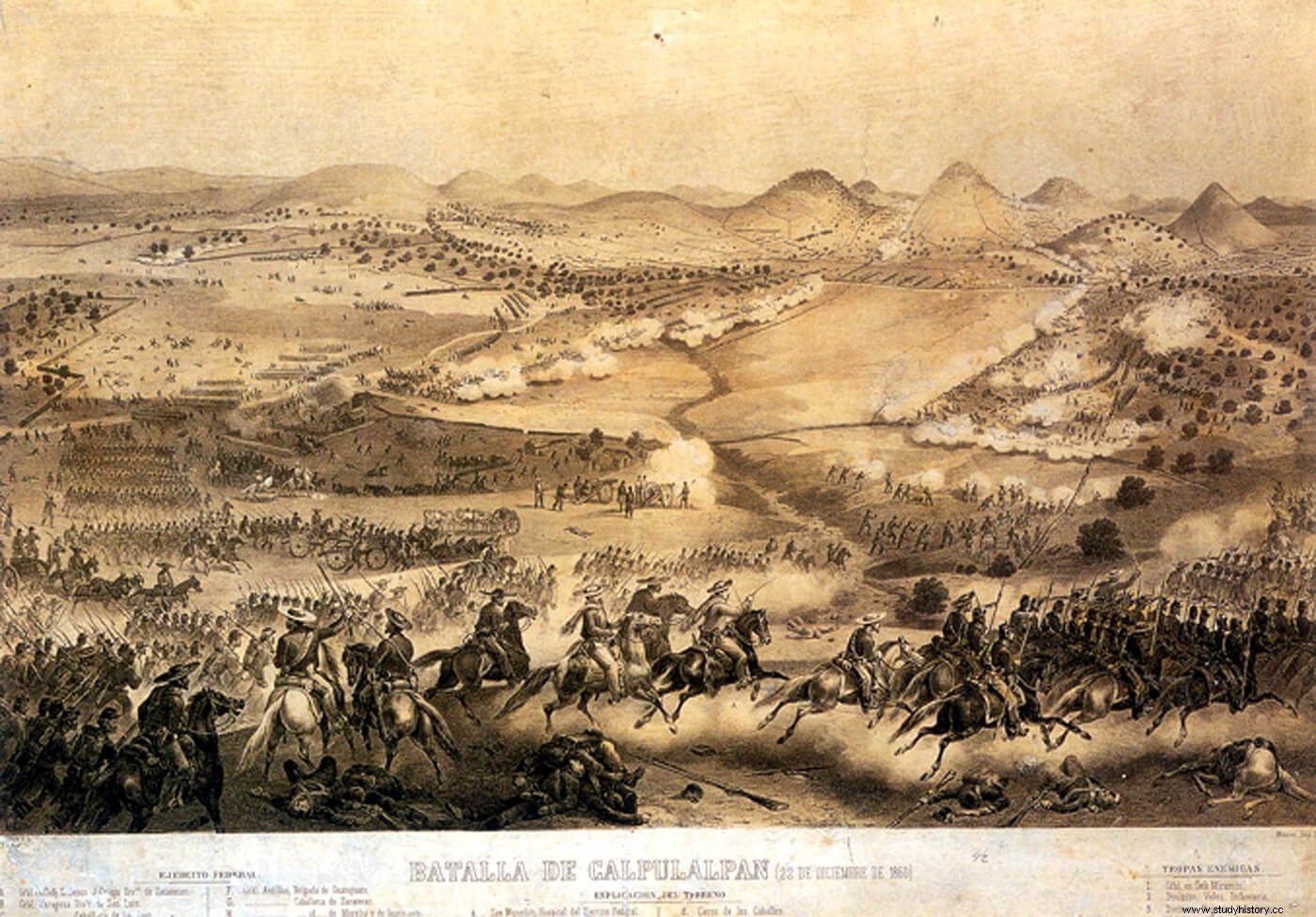
Finally, from June to January 1861, the army of the liberal government of Benito Juárez managed to conquer the important seats that were in the hands of the conservatives. On December 22, 1860, in the vicinity of San Miguel Capulalpan[5], the last battle of the war was fought. On January 11, 1861, Benito Juárez entered the Mexican capital and organized a new cabinet. After proclaiming elections he became the president of the country. The soldiers who had taken part against the constitutionalists were permanently discharged.
Consequences of the War of Reform
Apart from the casualties produced in the course of the campaign and the flight to Cuba of the conservative leader Miguel Miramón, the most important consequence of the War of Reform was the state of emergency into which Mexico entered due to diplomacy. The constitutionalists had established diplomatic relations with their American neighbor, something that allowed them to keep Veracruz, and keep other extraterritorial powers away. Instead, the Conservatives made diplomatic arrangements with European powers, such as Spain and France, which provided them with financial support during the war against the Liberals. After the end of this, the European powers asked the new government headed by Juárez to pay off these debts.
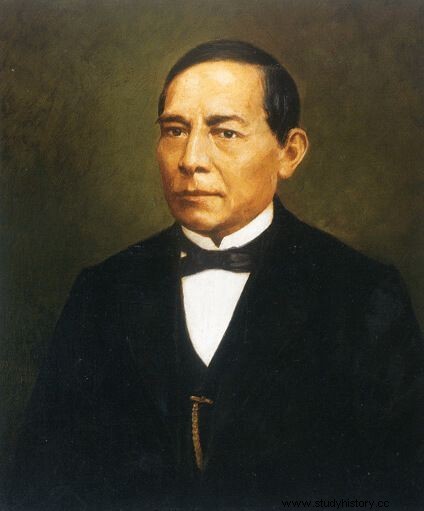
Mexico's new president expelled the diplomats first of these powers, although later he was forced to talk. Under a threat of intervention, the Mexicans managed to get Spain out of the way, which in the end decided not to intervene in the Latin American country. Instead, France, which was at the time an empire ruled by Napoleon III, decided to go ahead. In 1862 the French armies landed in Mexico. Juarez could not count on US help because they were fighting their own civil war. The war with France would not end until 1867.
Finally, and to finish, the liberal victory in the War of Reform led to profound social and economic changes in the structure of Mexico. The promulgation of the different laws, which had already been written in the Constitution of 1857, put an end to the ecclesiastical power, turning the new Republic of Mexico into a modern liberal State.
Basic bibliography
- Haworth S. Daniel (2000):Conservatives:Mexico City and the Reform War (1858-1860) . In “Relationships " . 84, Vol XII, University of Texas:Austin. P.97-131.
- Hernández López, Conrado (2008):The armed forces during the Reform War (1856-1867) . In “Historical signs " . January 19-June. Autonomous Metropolitan University, Federal District:Mexico. P.36-67.
- Labastida, Horacio (2010):Three-year war, intervention and restored republic . In “Documents for the history of independent Mexico 1808-1938 ”. Chamber of Deputies LXI legislature, Mexico D.F:Mexico. P. 353-382.
- Vidaurri Aréchiga, José Eduardo:The War of Reform. In Virtual University of the State of Guanajuato (UVEG), Mexico.
- VV. AA. (2018):Start of the Reform War in Mexico . National Institute of Historical Studies of the Revolutions of Mexico, Mexico City:Mexico.
[1] Vidaurri, p. 2.
[2] VV. AA, 2018, p. 12.
[3] Hernández, 2008, p. 52.
[4] Ibid., p. 49.
[5] VV. AA, 2018, p. 28
